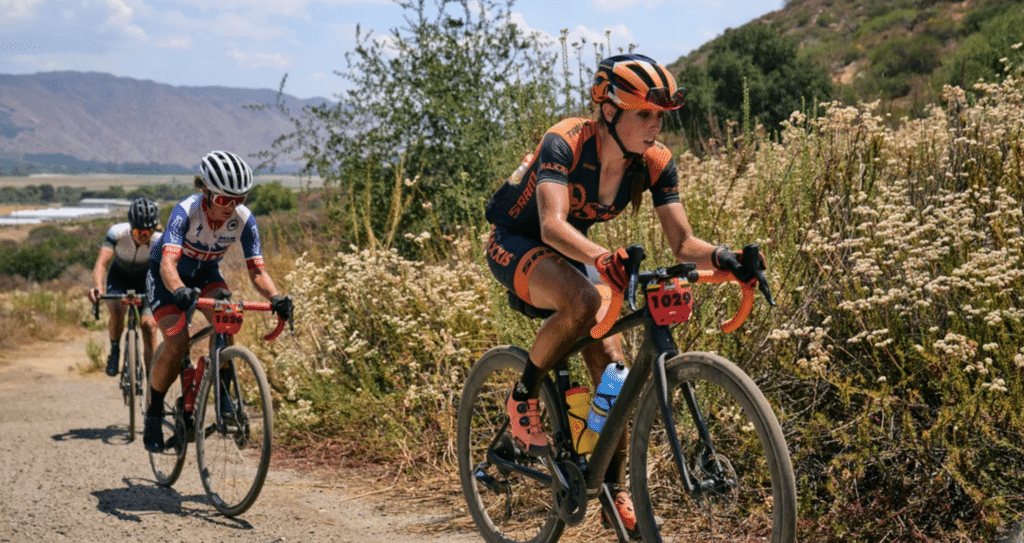How to set goals — that are specific, measurable, achievable, relevant, and timely — for more success on the bike.
FEBRUARY 10, 2022 HANNAH OTTO (FINCHAMP)
Posted by Velonews.com

When deciding what training plan to follow or even what workout to do on the bike today, the first thing you have to ask yourself is: “What are my goals?”
It can feel like a highly loaded and personal question. When you know someone’s goals you should be able to understand their daily actions as well. Everything we do brings us closer to — or further from — our goals. So that begs the question: What goals should we be setting for ourselves?
Types of goals:
It can be daunting to sit down and figure out a single goal that you want to devote your time and energy to and that’s because as people, we’re multi-faceted. It’s ok to have more than one goal, and if the goals complement each other, it’s actually advised. It can be difficult to stay motivated when your goal is several months away and you can use smaller goals to keep you accountable daily. I recommend setting two to three process, performance, and outcome goals to keep yourself motivated and dedicated.
Process goals:
A process goal is something that you control. In other words, the performance or actions of others will not impact your ability to reach your goal. Process goals are usually goals that you can accomplish more than once and on a daily or weekly basis. For example, a cycling-related process goal may be improved recovery, or preparation-based. You might make it a goal to stretch three times a week, to consume 20 grams of protein within 30 minutes of finishing a hard workout, and/or commit to getting at least eight hours of sleep every night.
Performance goals:
A performance goal is based on a personal standard. It’s a goal that your process goal will help you achieve. A few good performance goals might be to increase your FTP by 5 percent, improve your time by a specific amount on one of your favorite cycling routes, and/or hit a feature on a trail that you’ve never been able to do before. Performance goals may be challenging to reach because they stretch your own personal abilities, but the performance of others still should not impact your own goals.
Outcome goals:
Outcome goals are the results that you hope to achieve by completing your process and performance goals. Some examples of outcome goals might be to finish a race in a certain placement, to make it onto the roster of a competitive team, or to beat a specific competitor. Outcome goals are the goals where other people will be able to visibly see your success, so outcome goals are often the most exciting to set. It’s important to note though, that the performance of others will impact your outcome goal. For example, if your goal is to beat your friend in a race, but he or she has a mechanical in the first corner, your goal was much easier to achieve than you anticipated. On the other hand, if your friend trained extremely hard and improved drastically you might not achieve your goal despite your own improvement. It’s for this reason that outcome goals should be used to drive excitement, but performance and process goals can help guide your actions and indicate if you were on the right track.
How to set goals:
If you follow these principles, when you finish writing down your goals, you should have three to nine goals that can be separated into process-, performance-, and outcome goals. All of these goals should have something in common; they should be SMART goals.
Aim to have every goal you set be Specific, Measurable, Achievable, Relevant, and Timely.
In order to have a specific goal, make sure you narrow your focus. For example, don’t just make your goal to ride your bike ‘more’, make your goal to ride your bike 5 percent more than you did last year. Then make your goal, measurable. Decide how you will measure your goal. For example, do you want to ride 5 percent more in distance or in time than you did the year before. Next, check to make sure the goal is achievable. A 50 percent increase in ride distance from one year to the next, would be far out of reach for most people. Make sure your goal or goals are relevant. A climbing goal may hinder a distance goal or a travel goal may hinder your ability to ride your bike. Finally, make sure there is a time stamp on your goals, whether it be something you want to achieve over the course of a year or before a certain date, setting a specific time will help to keep you accountable.
Pursue your passions
Remember that the goals you set should excite you. If you don’t feel enthused by the goals you have set, it’s time to set new goals. Make sure that your goals reflect your passions.




 Since 1992, we at Escape Adventures have been blessed to shape and lead adventure travel vacations through some of the most awe-inspiring natural destinations in the world. Each successive season, our passion for adventure grows through memorable moments with our guests. Fresh air, faith, fitness and friends are the building blocks for our ventures, the treasured experiences that keep us moving forward. For those of you who have trekked and traveled with us over the past quarter century, Heather and I express our sincerest gratitude. The memories are priceless.
Since 1992, we at Escape Adventures have been blessed to shape and lead adventure travel vacations through some of the most awe-inspiring natural destinations in the world. Each successive season, our passion for adventure grows through memorable moments with our guests. Fresh air, faith, fitness and friends are the building blocks for our ventures, the treasured experiences that keep us moving forward. For those of you who have trekked and traveled with us over the past quarter century, Heather and I express our sincerest gratitude. The memories are priceless.